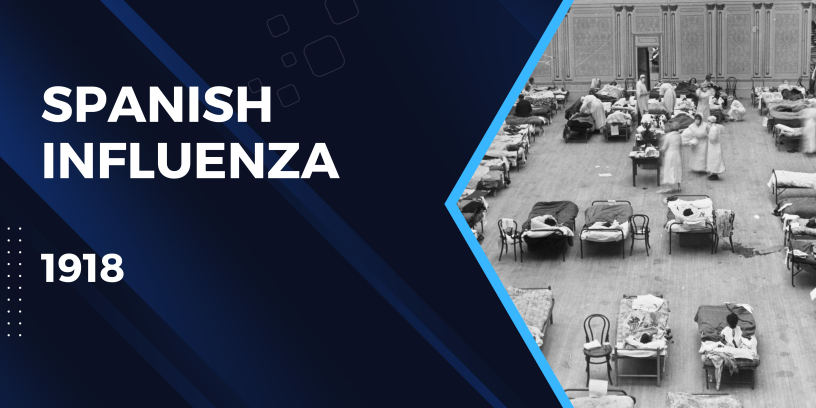1918 Spanish Influenza

The Spanish Flu of 1918 was a significant global pandemic that occurred following the end of World War I. Recognized as the deadliest pandemic in history, it affected approximately 500 million people worldwide, nearly a third of the population at that time. The pandemic claimed a minimum of 50 million lives, including 675,000 in the United States. In San Diego, this deadly influenza outbreak had a profound impact. It revealed the fragility of public health systems, tested the resilience of communities, and ultimately led to lasting changes in healthcare and pandemic preparedness.
Resources:
1. Documents:
- 19180114 Doc113880 San Diego Society for the Study and Prevention of Tuberculosis Re Care of Soldiers with Tuberculosis at Camp Kearney
- 19180116 Doc113939 Department of Public Health communication Re Doc113880 and Soldiers with Tuberculosis at Camp Kearney
- 19181025 Resolution24043 Requesting Citizens to Wear Gauze Masks During Influenza Epidemic
- 19181102 Doc118138 San Diego County Medical Society Communication Re Wearing Gauze Masks in Public Crowded Areas During Influenza Epidemic
- 19181202 Doc118689 Department of Public Health recommending General Quarantine during Influenza Epidemic
- 19181204 Resolution24128 Authorizing City Attorney to Prepare an Order for Quarantine of the City
- 19181206 Resolution24134 Appointing Physicians as Deputy Health Officers to Establish Quarantine on Influenza Cases
- 19181209 Doc119036 Health Officer Transmits the Recommendations Re the Control of Present Influenza Epidemic
- 19181209 Doc119040 City Attorney Communication Submitting an Ordinance to Require Universal Use of Gauze Masks
- 19181209 Resolution24140 Appointing a Committee of Doctors to Report on Influenza Situation
- 19181209 Resolution24141 Directing City Attorney to Prepare an Ordinance for Compulsory Use of Gauze Masks
- 19181211 Resolution24145 Permitting Removal of Gauze Masks while Bathing or Swimming
- 19181211 Resolution24147 Thanking the Red Cross for Help Against Spanish Influenza
- 19181211 Doc119060 Petition of Bath Houses for Permission to Enter Plunge without Gauze Masks
- 19181218 Doc119150 Department of Public Health Recommending Wearing Masks to be Continued
2. Additional Resources:
- Video: 1918: How A Flu Virus Became The World's Deadliest Pandemic (By World History Documentaries)
- Video: What Was the 1918 Influenza Pandemic? (By NIAID)
- Video: 1918 Flu Pandemic (By CDC)
For Middle & High School Students:
Tools:
1. Analyze a Photograph 2. Analyze a Document
Lesson Objectives:
Analyze and discuss the social, economic, and public health impacts of the Spanish Influenza on San Diego in 1918, as well as reflect on its lessons for today's pandemic preparedness.
Lesson Preparation:
Historical documents related to the 1918 Spanish Influenza and videos
Lesson Procedure:
Step 1: Historical Context: Provide an overview of the 1918 pandemic, its global impact, and the situation in the United States at the time. (Recommended Resource)
Step 2: Analyze Primary Sources:
-Distribute copies historical documents related to the 1918 influenza in San Diego. (see above)
-Ask students to analyze these documents in small groups looking for information about how the influenza affected the city socially, economically, and in terms of public health.
-Each group should present its findings to the class.
Step 3: Spanish Influenza vs COVID-19:
-Discuss briefly the COVID-19 pandemic and how it compares to the Spanish Influenza in terms of public health response, economic impact, and social disruption.
-Students will work in small groups to create a presentation comparing the response to the Spanish Influenza in 1918 with the response to COVID-19. They should identify similarities, differences, and lessons learned. Allow students time to research and gather information for their group projects using both online and offline resources.
-Each group presents its findings to the class, highlighting the lessons learned from the 1918 influenza and how they can be applied today.
Summary:
Students will be able to analyze and discuss the social, economic, and public health impacts of the Spanish Influenza on San Diego in 1918, as well as reflect on its lessons for today's pandemic preparedness.

